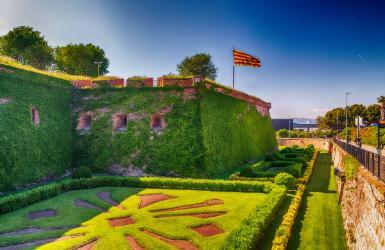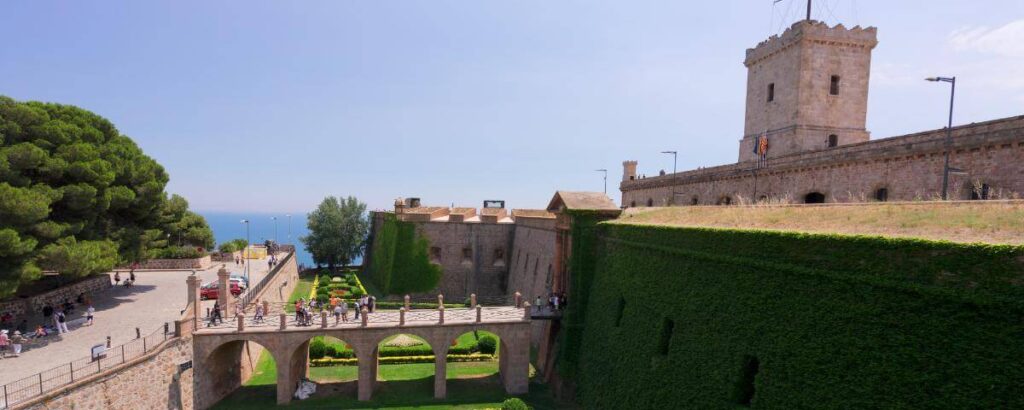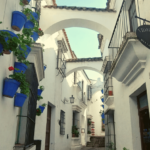
Visiting the Castle of Montjuic, a fortress in Barcelona
CASTELL DE MONTJUIC INSIDE VISIT
Did you know there’s a castle in Barcelona? A castle on a hill. And no, it’s not the white building next to an amusement park: that’s the church of the Holy Heart of the Tibidabo Mountain. I’m talking about the Castell de Montjuic, in the mountain that raises by the sea in the Southern end of the city. Its origins date back from 1073, when the first watch tower was documented on top of the hill. A sailor lived there to keep watch and alert the citizens about approaching enemy vessels. That beacon was fortified in the 1600’s, to protect Barcelona against the attacks of the fleet of Philip IV.
During the War of Succession in 1714 the fortress was heavily bombed and practically destroyed. The reconstruction of the castle started in 1753, following the plans of the military engineer Juan Martin Cermeño – the current image of the Montjuic castle is the result of such reconstruction, with some additions and improvements made in the following centuries.
After that moment the role of the Barcelona castle stopped being the defense of the city and became the repression of it. The castle has a dark past of cruel bombings against the city, mass arrests, torture and executions of civilians, thinkers, political leaders, anarchists, strike protestants… First by the Spanish monarchy and army, then by the Catalan republicans during the Spanish Civil War, and the horror continued under the dictatorship of Franco – all sides had blood on their hands.
Eventually in 1963, its military use finally declining, the fortress was turned into a military museum after 3 years of refurbishment works. With the death of General Franco in 1975 the democracy returned to Spain, but the negotiations to transfer the castle to the city of Barcelona lasted decades. Finally in 2007 the army accepted releasing the control of it and the military museum was dismantled. The Castle of Montjuic would never again be a threat for the Barcelonans.
1
What to see inside the Castle of Montjuic

OUTSIDE OF THE CASTLE
If your budget is limited, you may want to just see the castle from outside. The best pictures are taken from the small parking in front of the bridge over the moat. The moat isn't full of water, mind you: at the bottom there's a French-style topiary garden instead. There's a couple of big canons that kids love to climb for pictures. If you walk past the bridge towards the left you'll get to see views over the port, and if you pay attention, in the moat, near a large poplar tree you'll see a thin column with blue markings: it's the Hommage to the Metre.
It is there to celebrate that during 1792-93 the French scientist Pierre Méchain used the tower of the Montjuic Castle as a reference point to calculate the triangulations that would establish the geographic coordinates of Barcelona, and from there the basis of the metric system (sorry, don’t ask me how that works: math isn’t my thing…). Anyway, from that corner departs a path that allows you to walk around the entire structure of the castle in under 30 minutes if you want to follow it. It’s known as the “covered way”, not because it’s under roof, but because it was “covered” or protected by the fire from the bastions, its first line of defense.
Or if you don’t want to walk that much, just go right instead, and past the cable car station you’ll see the Fossar de Santa Eulàlia: the part of the moat that works now as an archery field: there was executed the Catalan President Lluis Companys during the dictatorship of general Franco.
BASTION OF SANT CARLES
If you decided to pay the entrance fee, after getting your ticket scanned you’ll take an elevator to the top of the Bastion of Sant Carles. Besides the great views over the industrial port and the cruise piers, here you’ll find a couple of cannons, as well. You’ll also find there a bronze sculpture of a Venus dedicated to Gaspar Portola, first governor of California and born in Catalonia in 1717.
PARADE GROUND
You’ll find here a cafe, toilets and the Interpretation Centre exhibit rooms.
UPPER TERRACE AND WATCHTOWER
At the opposite end of the parade ground you’ll find the staircase leading to the upper terrace (the staircase divides into two stairs – both lead to the same place, it makes no difference which one you take). The terrace is probably the best part of the visit, with its 360º views over Barcelona and the Mediterranean sea. At the opposite side of the terrace stands a watchtower, featuring two sundials and an a memorail plaque about Pierre Méchain and his calculations. The tower is unfortunately closed to the public, but it was used as a communications tower and apparently it still preserves inside its original telegraph network.
SANTA AMALIA BASTION
If you don’t have much time, after visiting the upper terrace your visit could end there, retracing your steps back down, through the parade ground and the tunnel, then taking the slopes down to the exit. But if you want to see more, after exiting the tunnel you can continue left to the Santa Amalia Bastion. There’s no cannons left there anymore, as all the batteries pointing to the city were dismantled after the Ministry of Defense transferred the control of the Castell de Montjuic to the Barcelona City Council in 2007.
In this bastion you can see a well with wrought iron decorations. The water came from an underground cistern that collected rainwater and provided water to the castle. From here you get also good views over the Santa Eulalia moat where president Companys was executed, and you can appreciate really well the scarp of the castle: the edges of the walls built on a small slope covered with weeds in imitation of the shape of hill: a clever way to camouflage the castle from the distance.
HORNWORK AND RAVELIN
Nowadays the connection between horns is decorated by an orange tree garden where you’ll also find a sculpture to the Timbaler del Bruc, a drummer that is said to have been key to the defeat of the army of Napoleon in his first attempt of conquering the Monastery of Montserrat.
If instead of walking down the garden you take the path that surrounds the castle, halfway down you’ll find the slope to access the moat of Santa Helena and the ravelin. A ravelin is a triangular structure strategically placed between the edges of the hornwork. It’s function is to force the enemy to split and immediately get exposed under the fire of the defenders positioned at the top of the hornwork.
At the right end of the moat stands a memorial from 1940, in honor of the prisoners of the nationalist side (the dictator Franco’s side) executed by the republicans in that very moat during the Spanish Civil War. It gives me the chills to think that a memorial about those that rose against democracy is still there… Anyway, the other end of the moat leads to the two last bastions of the castle: the Velasco and the Llengua de Serp bastions and their lunettes, but that part of the castle is nowadays not open to visitors and it’s occupied by a telecommunications facility.
SEA WALL
After visiting the moat of the ravelin, go back to the top of the hornwork, where you’ll see two more cannons. Then you’ll walk down the last section of the castle wall: the one that overlooks the sea. This side of the castle perimeter housed the dormitories of the garrison. Five small windows almost at ground level were the only point of natural light into the 5 dungeons of the castle. At the end of the sea wall you’ll be back to the bastion of Sant Carles, and from there you’ll be around the corner from the ramp that takes you to the exit.
2
How to get to Montjuic Castle
CABLE CAR
There’s two cable cars in Barcelona, but only one of them goes all the way up to the castle: the Teleferic de Montjuic. Unfortunately, the cable car doesn’t connect directly with the city: you need to take the funicular from Paral·lel (L2 and L3 metro lines), then switch to the cable car. Or walk there. Or take the 55 or 150 buses, or the red route of the Tourist Bus. There’s often lines, so buying tickets online is always a good idea. And the views are breathtaking.
150 BUS
To visit Montjuic Castle you can take the 150 bus from Plaça Espanya. The stop is located near the Tourist Information Point, between the Venitian Towers and Avinguda Paral·lel. The bus runs every day 7AM-9PM, with a frequency of 10-15 minutes, and it takes almost 30 minutes (15 stops) to take you to Castell, the bus stop #2315, right under the Montjuic Castle.
WALKING
If you are up for a hike, I recommend you to start from Plaça Espanya and walk the stairs (or take the escalators) up to the Palau National building, the MNAC museum. Walk around it from the left and follow the road up passed the Museum of Ethnology, then around the Laribal Gardens (I personally prefer to take the path that goes sort of parallel to the road inside the park, for a more tranquil stroll). Continue heading left until you hit the Miro Foundation. Only 5 minutes walk further you’ll see the Cable Car bottom station. From here you’ll just need to keep going uphill, using the cable car lines as a reference. You can take the road, or cross the Joan Brossa or the Mossen Cinto Verdaguer gardens until you reach the castle. This route takes about 1 hour.
Alternatively, if you prefer to take a detour and see more of the Montjuic Hill, at the MNAC go instead around it through the right. You’ll soon see the escalators that take you to the Olympic Stadium, and from there you’ll go left, hitting the Miro Foundation on less than 10 minutes. But it’s at the top of the Hill: you can’t get lost. This other route is just under 10 minutes longer. BTW, mind that the fortress was built to be hidden from the enemy, so it’s not really visible until you are right there.
3
Castell de Montjuic opening hours & tickets
OPENING HOURS
- The Castillo de Montjuic opens every day, except December 25 and January 1.
- The opening hours are 10AM to 6PM, March to October extending the visit up to 8PM.
- The ticket offices close 30 minutes before closing time.
TICKETS
- The ticket office is located inside: go over the bridge over the moat, and as soon as you enter the gate you’ll see a door to the left that leads to the ticket office and the beginning of the visit.
- If you have already purchased your tickets online, there’s a separate lane next to the line to purchase tickets.
- It is possible to rent radioguies or join a guided tour for an extra fee. Guided tours in English take place on Saturdays, Sunday and local holidays at 1PM, and in August also Wednesday-Sunday at 11PM and 3PM.
- Visit is free on the first Sunday of every month, and every Sunday from 3PM. The lines to get in on such days tend to be long.
4
Things to do near this fortress on the Hill of Montjuic
- Take the easy hiking path overlooking the port that goes behind the Montjuic Castle to the Mirador del Migdia and enjoy drinks or an outdoors lunch at its popular “chiringuito” restaurant called La Caseta del Migdia.
- Enjoy the views from Mirador de l’Alcalde.
- Take the kids to the Joan Brossa gardens, where there’s two giant slides, musical cushions and several fun playgrounds.
- Swim with views over the city at the Municipal Olympic Pools (Summer season only, but the rest of the year you can enjoy a drink at its bar)
- Visit the Miro Foundation.
- And in this post you’ll find more things to do in Montjuic.
RESEARCHING FOR A TRIP IS TIME-CONSUMING…
Need more inspiration?
Our 100% FREE Barcelona Collection will give you everything you need to organize the trip of your lifetime to Barcelona.
BEST INSIDER TIPS FROM THE PROS!








